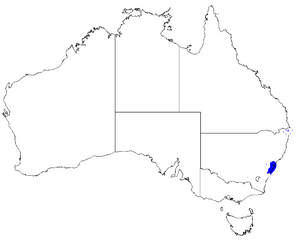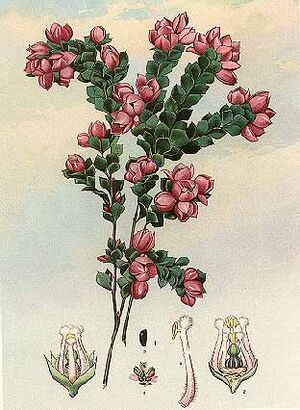Native rose facts for kids
Quick facts for kids Native rose |
|
|---|---|
 |
|
| Boronia serrulata in Ku-ring-gai Chase National Park | |
| Scientific classification | |
 |
|
| Occurrence data from Australasian Virtual Herbarium |
The Boronia serrulata, often called native rose or rose boronia, is a special plant. It belongs to the citrus family, called Rutaceae. This plant is only found in New South Wales, Australia, mostly around the Sydney Basin. It's a woody shrub that stands upright. It has smooth branches and simple, egg-shaped leaves with tiny teeth on their edges. Its bright pink flowers, each with four petals, grow at the ends of its branches.
Contents
What Does Native Rose Look Like?
The native rose is an upright, woody shrub. It usually grows to be about 1.5 meters (5 feet) tall. Its branches are mostly smooth. The leaves are packed closely together and are simple. They are broadly egg-shaped, about 6 to 18 millimeters long and 1.5 to 9 millimeters wide. They don't have a stalk, meaning they attach directly to the stem. Both sides of the leaf are the same color, and their edges have fine teeth, like a tiny saw.
Up to seven cup-shaped flowers grow at the ends of the branches. They are on a main stalk, called a peduncle, which is up to 3.5 millimeters long. Each individual flower might also have a short stalk, called a pedicel, up to 3.5 millimeters long.
The flower has four triangular sepals. These are small leaf-like parts that protect the bud. They are about 2.5 to 3 millimeters long. The four petals are bright pink and are 6 to 11 millimeters long. Inside the flower, there are eight stamens. These are the parts that make pollen. They have a fuzzy tuft of hairs near their tips. The stigma, which is the part that receives pollen, is very large and hides the style (the stalk connecting the stigma to the ovary).
Native rose flowers from August to November. After flowering, it produces a fruit. This fruit is a capsule, which is a dry fruit that splits open to release seeds. It's mostly smooth and about 4 millimeters long and 2 millimeters wide.
How Native Rose Got Its Name
The native rose was first officially described in 1798. This was done by a scientist named James Edward Smith. He wrote about it in his book Tracts relating to natural history.
The second part of its scientific name, serrulata, comes from a Latin word. The Latin word serra means "saw." The "serrulata" part means "little saw." This name was chosen because the edges of the plant's leaves have fine teeth, just like a tiny saw.
Where Native Rose Lives
Native rose grows in sandy soil. It likes moist, open areas called heathlands. You can find it mainly in the coastal parts of the Sydney basin in New South Wales.
Growing Native Rose in Gardens
Many people think the native rose is a very pretty shrub. Its bright green leaves have a nice smell when you crush them. It's easiest to grow this plant from cuttings. These are small pieces of the plant taken in early summer. The plant grows best in soil that drains water well. It also likes its roots to stay cool.
See also
 In Spanish: Boronia serrulata para niños
In Spanish: Boronia serrulata para niños


